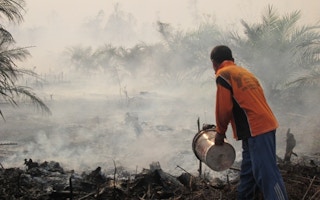Indonesia’s peat restoration agency is advocating for greater foreign investment to fill an expected funding shortfall in the government’s plan to rehabilitate more than 2 million hectares of peat across seven provinces.
“We do believe there are foreign parties who are willing to help finance the restoration of peat across Indonesia,” Peatland Restoration Agency (BRG) chief Nazir Foead said in Jakarta on Monday. “If we are to rely on [corporate social responsibility] and grants the restoration target will not be met.”
The comments from the BRG come as Indonesia’s Ministry of Finance readies a reform package to provide incentives to invest in peat rehabilitation.
The World Bank has estimated the initial cost to restore the government’s target of 2 million hectares of peat at 27 trillion rupiah ($2.1 billion). That figure includes the vital initial work, such as blocking drainage canals, but does not price-in the longer term costs associated with maintaining restored peatland.
“
We do believe there are foreign parties who are willing to help finance the restoration of peat across Indonesia.
Nazir Foead, chief, Peat Restoration Agency (BRG)
The BRG is prioritising peat burned in the 2015 Southeast Asian haze crisis; intact peat domes; peat domes with drainage canals; and non-domed peat with drainage canals.
All peat domes — a peat dome is an especially deep peatland — will remain protected but some other land will be determined for cultivation. The agency has already released an indicative peatland map from which to base its restoration efforts.
Foead signed a decree on September 14 detailing the target restoration across seven provinces. Riau province is the largest site for restoration, with a target of 836,410 hectares.
Indonesian President Joko “Jokowi” Widodo is expected to soon sign a presidential regulation codifying the remit of the peat restoration program.
Data from NASA’s Aqua and Terra satellites via Global Forests Watch show a marked week-to-week reduction in fire alerts across Indonesia as the arrival of September monsoons caused fatal flooding in some parts of the archipelago. From September 19-25 the satellites recorded 307 fire alerts, down from 1,247 the previous week. In the same week last year the data showed 15,029 fire alerts — 2 percent of the total from September 19-25, 2015.
In addition, 44 per cent of those fires occurred on peat in 2015 while the data show 18 per cent of the fire alerts from last week were recorded in peatlands.
Separately, Indonesia’s environment ministry has moved to issue five timber companies with administrative sanctions for complicity in wildfires burning on their concessions. All five of the companies operate in Riau province — the five were each served with SP3 notices by the provincial police force earlier this year, a move which generated significant controversy and caused Indonesia’s police chief to declare that such notices could be issued only by the National Police in the future.
Environment minister Siti Nurbaya Bakar said the ministry had revoked altogether the licenses of three forestry companies — PT Dexter Timber Perkasa, PT Hutani Sola Lestari and PT Siak Raya Timber. Land from the latter two concessions, the minister said, would be converted into a buffer zone for Tesso Nilo National Park.
The ministry has also suspended PT Sumatera Riang Lestari from operating and instructed PT Rimba Lazuardi to take additional fire-control measures. Most of these firms are associated with either Asia Pulp & Paper or Asia Pacific Resources International Limited, Indonesia’s largest pulp and paper conglomerates.
This story was published with permission from Mongabay.










